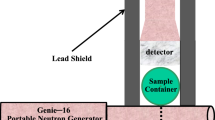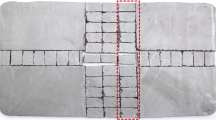Abstract
A prompt gamma neutron activation analysis facility has been designed, built, and characterized at the Oregon State University TRIGA® reactor. This facility was designed for versatile multi-elemental analyses. The facility utilizes the leakage neutrons originating from beam port #4 of the Oregon State University TRIGA® reactor. The neutrons are collimated through a series of lead and Boral® collimators, and filtered through both a bismuth filter and single-crystal sapphire. Samples are irradiated in a sample chamber outside the biological shielding of the reactor, and the resulting gamma radiation produced from neutron interactions within the sample is monitored using a high-purity germanium detector (HPGe). The thermal and epithermal neutron fluxes were measured using gold-foil irradiations and found to be 2.81 × 107 and 1.70 × 104 cm−2 s−1, respectively. The resulting cadmium ratio was 106. Measured detection limits for boron, chlorine, and potassium in a NIST SRM 1571 orchard leaf were 5.6 × 10−4 mg/g, 8.2 × 10−2 mg/g, and 1.0 mg/g, respectively. Detection limits for additional elements and samples are presented.
















Similar content being viewed by others
References
Molnár GL, Révay Z, Belgya T, Firestone RB (2000) The new prompt gamma-ray catalogue for PGAA. Appl Radiat Isot 53:527–533
Mackey EA, Anderson DL, Liposky PJ, Lindstrom RM, Chen-Mayer H, Lamaze GP (2004) New thermal neutron prompt gamma-ray activation analysis instrument at the National Institute of Standards and Technology Center for neutron research. Nucl Instrum Methods Phys Res B 226:426–440
Belgya T, Révay Z, Molnar GL (2004) Gamma-ray background at the Budapest PGAA facility. J Radioanal Nucl Chem 265:181–191
Révey Z, Harrison RK, Alvarez E, Biegalski SR, Landsberger S (2007) Construction and characterization of the redesigned PGNAA facility at the University of Texas at Austin. Nucl Instrum Methods Phys Res A 577:611–618
Molnar GL (2004) Handbook of prompt gamma activation analysis. Kluwer, Boston/London
Sueki K, Kobayashi K, Sato W, Nakahara H, Tomizawa T (1996) Nondestructive determination of major elements in a large sample by prompt gamma ray neutron activation analysis. Anal Chem 68:2203–2209
Adib M, Kilany M (2002) On the use of bismuth as a neutron filter. Radiat Phys Chem 66:81–88
Shirane G, Shapiro SM, Tranquada JM (2002) Neutron scattering with a triple-axis spectrometer: basic techniques. Cambridge, New York
Sears VF (1989) Neutron optics. Oxford, New York
Knoll GF (2000) Radiation detection and measurement. Wiley, Michigan
Chasman C, Jones KW, Ristinen RA (1965) Fast neutron bombardment of a lithium-drifted germanium gamma-ray detector. Nucl Instrum Methods 37:1–8
Currie LA (1968) Limits for qualitative detection and quantitative determination. Anal Chem 40:586–593
Dzubay TG (1977) X-ray fluorescence analysis of environmental samples. Ann Arbor Science Publisher INC, Ann Arbor, MI
Hartman MR, Rush JJ, Udovic TJ, Bowman RC Jr, Hwang SJ (2007) Structural and vibrational dynamics of isotopically labeled lithium borohydride using neutron diffraction and spectroscopy. J Solid State Chem 180:1298–1305
Renaudine G, Gomes S, Hagemann, Keller L, Yvon K (2003) Structural and spectroscopic studies on the alkali borohydrides MBH4 (M = Na, K, Rb, Cs). J Alloys Compd 375:98–106
Acknowledgments
We would like to thank the reactor operations staff at the OSTR for working with us to construct, install, and characterize the instrument. We would also like to thank Dr. Gregory Downing at NIST for providing us with the sample chamber for this instrument.
Author information
Authors and Affiliations
Corresponding author
Rights and permissions
About this article
Cite this article
Robinson, J.A., Hartman, M.R. & Reese, S.R. Design, construction and characterization of a prompt gamma activation analysis facility at the Oregon State University TRIGA® reactor. J Radioanal Nucl Chem 283, 359–369 (2010). https://doi.org/10.1007/s10967-009-0358-2
Received:
Accepted:
Published:
Issue Date:
DOI: https://doi.org/10.1007/s10967-009-0358-2




